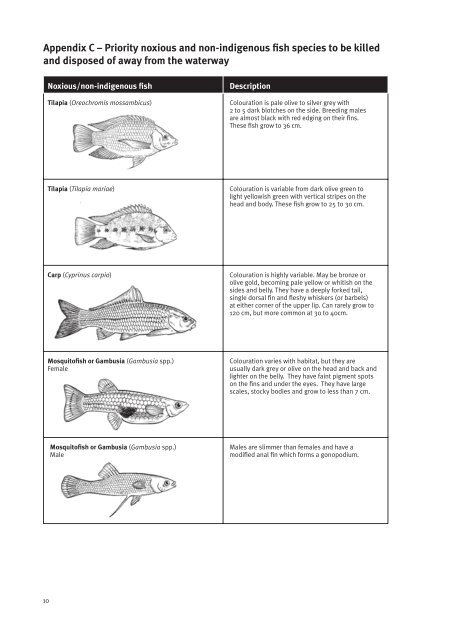Fish salvage guidelines - Department of Primary Industries
Fish salvage guidelines - Department of Primary Industries
Fish salvage guidelines - Department of Primary Industries
You also want an ePaper? Increase the reach of your titles
YUMPU automatically turns print PDFs into web optimized ePapers that Google loves.
Appendix C – Priority noxious and non-indigenous fish species to be killed<br />
and disposed <strong>of</strong> away from the waterway<br />
Noxious/non-indigenous fish<br />
Tilapia (Oreochromis mossambicus)<br />
Description<br />
Colouration is pale olive to silver grey with<br />
2 to 5 dark blotches on the side. Breeding males<br />
are almost black with red edging on their fins.<br />
These fish grow to 36 cm.<br />
Tilapia (Tilapia mariae)<br />
Colouration is variable from dark olive green to<br />
light yellowish green with vertical stripes on the<br />
head and body. These fish grow to 25 to 30 cm.<br />
Carp (Cyprinus carpio)<br />
Colouration is highly variable. May be bronze or<br />
olive gold, becoming pale yellow or whitish on the<br />
sides and belly. They have a deeply forked tail,<br />
single dorsal fin and fleshy whiskers (or barbels)<br />
at either corner <strong>of</strong> the upper lip. Can rarely grow to<br />
120 cm, but more common at 30 to 40cm.<br />
Mosquit<strong>of</strong>ish or Gambusia (Gambusia spp.)<br />
Female<br />
Colouration varies with habitat, but they are<br />
usually dark grey or olive on the head and back and<br />
lighter on the belly. They have faint pigment spots<br />
on the fins and under the eyes. They have large<br />
scales, stocky bodies and grow to less than 7 cm.<br />
Mosquit<strong>of</strong>ish or Gambusia (Gambusia spp.)<br />
Male<br />
Males are slimmer than females and have a<br />
modified anal fin which forms a gonopodium.<br />
10

















